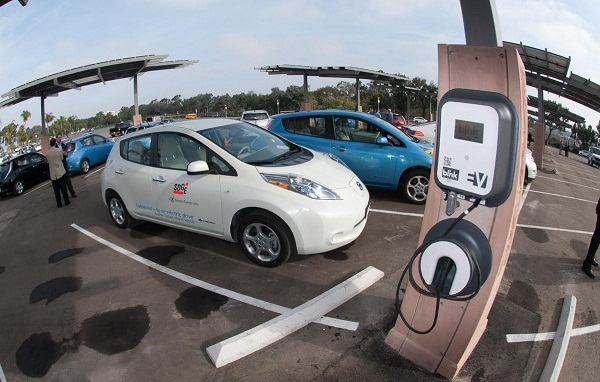It’s always nice when a real live scientist who actually knows what he’s talking about steps in and confirms your half-baked suspicions.
And so Roland Geyer, at UC Santa Barbara, has done. His life-cycle analysis shows that using solar power to create electricity to run electric vehicles is a far more efficient way to lower greenhouse gas emissions than turning plants into liquid fuels to replace conventional gasoline (or using the plants to produce electricity to run battery electric cars, for that matter).
Plus, charging EVs with PV-produced energy is cost-competitive with using biofuels.

Obnoxious as it is, we can’t help but respond to this news by quoting our own view, from a January 2012 EarthTechling column that argued the case against biofuels:
Biofuels advocates have often responded to such criticism by noting that despite its shortcomings, biofuels are useful because unlike solar or wind, they are fuels that can go in our cars and help us meet our transportation needs. But in truth, we don’t need them to go in our cars. We don’t need cars that run on them. We need to move past that entire paradigm. Let’s go electric. Then we can embrace a full range of renewable energy sources – real solar, and wind, and whatever else proves itself worthy – not a woefully ineffectual one.
This opinion flowed from the work of Oregon State University economist Bill Jaeger, who has demonstrated that biofuels lose their carbon neutrality when fossil fuels are used to transport them and when farmers use nitrogen fertilizers (made using natural gas) to grow feedstocks – and that using valuable farmland for growing biofuel feedstocks can push food production onto previously uncleared land, which releases carbon accumulated in soil and vegetation.
“The more you look at it,” Jaeger told us, “the more it’s clear there is something fundamentally amiss about trying to grow stuff to make a liquid that can then be a fuel. If you think about it, it’s a very convoluted way to use solar energy, where instead of photovoltaics, you’re relying on photosynthesis and a lot of other inputs. It just doesn’t pencil out.”
Now get a load of the essential question Geyer said he was asking in his study: “The energy source for biofuels is the sun, through photosynthesis. The energy source for solar power is also the sun. Which is better?”
His conclusion was that PV kicks biofuel butt.
“PV is orders of magnitude more efficient than biofuels pathways in terms of land use – 30, 50, even 200 times more efficient – depending on the specific crop and local conditions,” Geyer said. “You get the same amount of energy using much less land, and PV doesn’t require farm land.”
And then there’s this: “PV [battery electric vehicle] systems also have the lowest life-cycle GHG emissions throughout the U.S. and the lowest fossil fuel inputs, except in locations that have very high hypothetical switchgrass yields of 16 or more tons per hectare.”
PV conversion even wins compared to the vaunted next-generation of biofuels, cellulosic biofuels that use nonfood matter, Geyer said. They face the same essential issue that corn-grain ethanol faces: “The bottleneck for biofuels is photosynthesis,” Geyer says. “It’s at best 1-percent efficient at converting sunlight to crop, while today’s thin-film PV is at least 10-percent efficient at converting sunlight to electricity.”
The study didn’t formally compared the costs of biofuels vs. PV, but Geyer said “quick calculations suggests that with the federal tax credit, electric vehicles are already competitive.”
Geyer’s paper, written with David Stoms and James Kallaos, appeared in the Dec. 26, 2012, issue of the journal Environmental Science & Technology.